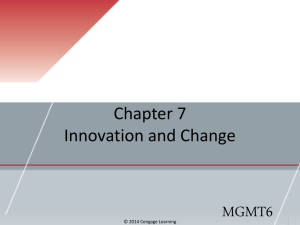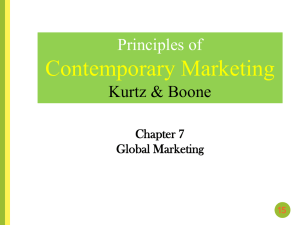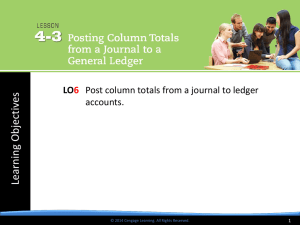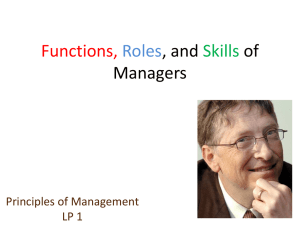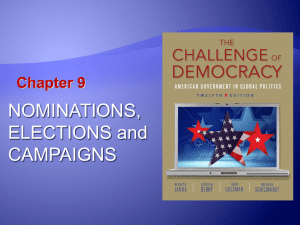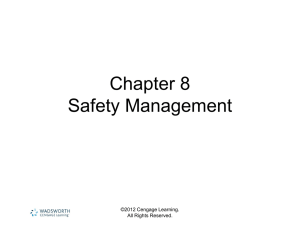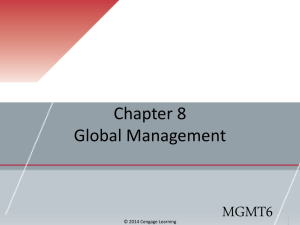Chapter 10
advertisement
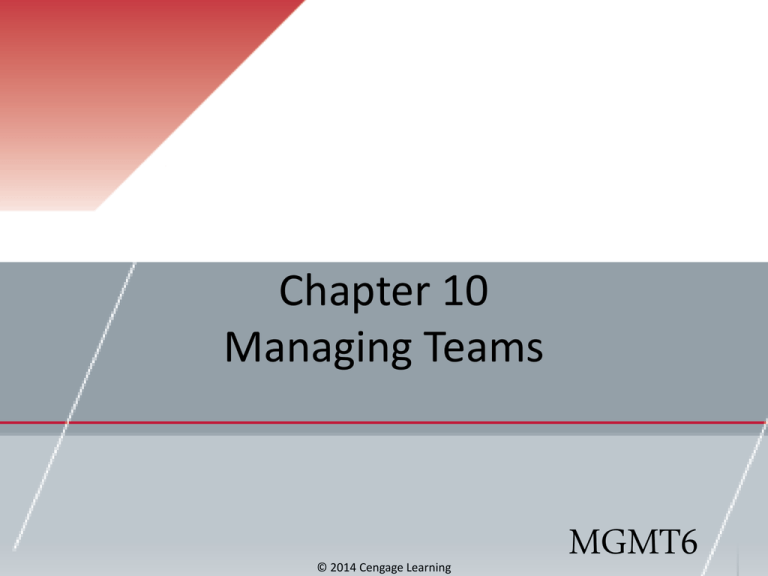
Chapter 10 Managing Teams © 2014 Cengage Learning MGMT6 10-1 explain the good and bad of using teams 10-2 recognize and understand the different kinds of teams 10-3 understand the general characteristics of work teams 10-4 explain how to enhance work-team effectiveness © 2014 Cengage Learning The Advantages of Teams Teams improve… • • • • Customer satisfaction Product and service quality Product development speed and efficiency Employee job satisfaction – Cross-training • Decision making © 2014 Cengage Learning 10-1 The Disadvantages of Teams • Initially high turnover • Social loafing • Groupthink • Minority domination © 2014 Cengage Learning 10-1 © 2014 Cengage Learning 10-1 Autonomy The degree to which workers have the discretion, freedom, and independence to decide how and when to accomplish their jobs. © 2014 Cengage Learning 10-2 © 2014 Cengage Learning 10-2 Special Kinds of Teams • Cross-functional teams • Virtual teams • Project teams © 2014 Cengage Learning 10-2 Work Team Characteristics • Team norms • Team cohesiveness • Team size • Team conflict • Stages of team development © 2014 Cengage Learning 10-3 Team Norms Informally agreed-on standards that regulate team behavior. • Regulate the everyday actions that allow teams to function effectively • Teams with negative norms influence team member to engage in negative behaviors © 2014 Cengage Learning 10-3 Team Cohesiveness The extent to which team members are attracted to a team and motivated to remain in it. •Make sure that all team members are present at team activities. •Create additional opportunities for teammates to work together. •Engage in nonwork activities. •Make employees feel they are part of a special organization. © 2014 Cengage Learning 10-3 Team Size • In very large teams, members find it difficult to get to know one another, and team can splinter into subgroups. • Very small groups may lack diversity and knowledge found in large teams. © 2014 Cengage Learning 10-3 Team Conflict • Cognitive conflict – members disagree because of different experiences and expertise • Affective conflict – results in hostility, anger, resentment, distrust, cynicism, apathy • Emphasizing c-type conflict is not enough 10-3 © 2014 Cengage Learning Having a Good Fight • Work with more, not less, information • Develop multiple alternatives to enrich debate • Establish common goals • Inject humor into the workplace • Maintain a balance of power • Resolve issues without forcing a consensus © 2014 Cengage Learning 10-3 © 2014 Cengage Learning 10-3 Setting Team Goals and Priorities • Increasing a team’s performance is inherently more complex than just increasing one person’s performance. • Challenging team goals affect how hard team members work. © 2014 Cengage Learning 10-4 Stretch Goals Extremely ambitious goals that workers don’t know how to reach. •Teams must have a high degree of autonomy •Teams must be empowered with control over resources •Structural accommodation •Bureaucratic immunity © 2014 Cengage Learning 10-4 Selecting People • Individualists – put their own welfare and interests first • Collectivists – put group interests ahead of self • Team level – the average level of ability, experience, personality, or any other factor on a team • Team diversity – variances or differences in ability, personality, or any other factor on a team © 2014 Cengage Learning 10-4 © 2014 Cengage Learning 10-4 Team Training • Interpersonal skills • Decision making skills • Problem solving skills • Conflict resolution skills • Technical training © 2014 Cengage Learning 10-4 Team Compensation • Skill-based pay – pay employees for learning additional skills or knowledge • Gainsharing – companies share the financial value of performance gains with their workers • Nonfinancial rewards – vacations, T-shirts, awards, certificates © 2014 Cengage Learning 10-4 Holden Outerwear 1. 2. 3. <click screenshot for video> What type of team did Nikki Brush participate in when she was a freelancer?What type of team does she participate in as a full-time employee at Holden? What are the advantages and disadvantages of using teams at Holden? What can managers do to help avoid the disadvantages? What steps do the leaders of Holden take to insure that their workgroups have high levels of cohesion? © 2014 Cengage Learning

